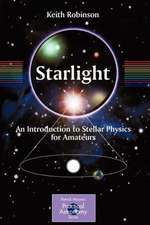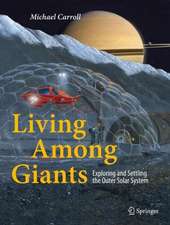Return to the Moon: Exploration, Enterprise, and Energy in the Human Settlement of Space
Autor Harrison Schmitten Limba Engleză Paperback – 18 oct 2010
| Toate formatele și edițiile | Preț | Express |
|---|---|---|
| Paperback (1) | 279.59 lei 3-5 săpt. | |
| Springer – 18 oct 2010 | 279.59 lei 3-5 săpt. | |
| Hardback (1) | 285.26 lei 3-5 săpt. | |
| Springer – 17 oct 2006 | 285.26 lei 3-5 săpt. |
Preț: 279.59 lei
Nou
Puncte Express: 419
Preț estimativ în valută:
53.51€ • 55.74$ • 44.49£
53.51€ • 55.74$ • 44.49£
Carte disponibilă
Livrare economică 20 ianuarie-03 februarie 25
Preluare comenzi: 021 569.72.76
Specificații
ISBN-13: 9781441920256
ISBN-10: 1441920250
Pagini: 352
Ilustrații: XVI, 336 p.
Dimensiuni: 155 x 235 x 18 mm
Greutate: 0.54 kg
Ediția:Softcover reprint of hardcover 1st ed. 2006
Editura: Springer
Colecția Copernicus
Locul publicării:New York, NY, United States
ISBN-10: 1441920250
Pagini: 352
Ilustrații: XVI, 336 p.
Dimensiuni: 155 x 235 x 18 mm
Greutate: 0.54 kg
Ediția:Softcover reprint of hardcover 1st ed. 2006
Editura: Springer
Colecția Copernicus
Locul publicării:New York, NY, United States
Public țintă
Popular/generalDescriere
The Moon is not just a "local" destination, argues former NASA Astronaut Harrison Schmitt. As a destination, the Moon presents us with a goal that tests our resourcefulness and determination. How much are we willing to spend to re-establish ourselves as space-farers? Return to the Moon proposes that we begin planning, and now, for the establishment of human outposts on the Moon — not just as an exercise in technology and discovery, and not just as a way of fulfilling our destiny as explorers and pioneers. Schmitt, having himself traveled to and literally walked on the Moon, is no stranger to technology, discovery, and a sense of our destiny as explorers; but in this book he focuses on a return to the moon as a business proposition.
Cuprins
Introduction: 25 Years from Today.- The Legacy of Apollo: The geopolitical, cultural, and scientific legacy of Apollo, including the discovery of lunar energy resources.- Global Energy in the 21st Century: The increasing future demand for energy and the alternatives to meet that demand including lunar Helium-3 fusion.- Fundamentals of Helium-3 Fusion: The basic principles of Helium-3 fusion including its advantages and disadvantages relative to other energy alternatives.- Lunar Helium-3 Resources: How much we know about the concentration, distribution, and geology of lunar Helium-3 and related resources.- Economic Approaches to a Return to the Moon: Comparison of various combinations of private, federal, and international approaches to funding and managing a return to the Moon.- Lessons from Apollo Management: The nature of the Apollo management system and the lessons that can be drawn from its successes and failures.- Private Business/Investor Approach: The details and milestones in a private business and investor-based approach to a return to the Moon.- Bridging Businesses: Bridging businesses that apply helium-3 fusion technologies; in particular, positron emitting isotope production for medical diagnostics (PET), and a general discussion of other, follow-on bridging businesses.- Lunar Resource Production Operations: The essential elements of the initiation and early operation of a lunar resource production and processing endeavor.- Ancillary Businesses: The use of technologies developed for accessing and using lunar Helium-3 for space exploration, astronomy from the Moon, space tourism, diversion of asteroids and comets, and national security.- Space Law Related to Lunar Resources: Lunar resource development in the context of international law and specifically of the Outer Space Treaty of 1967.- Human vs Machine Roles in Space Exploration and Development: The relative merits of human and robotic systems in space.- Long-term Implications: The long-term implications of the development of lunar resources on the betterment of the human condition, the advancement of civilization, the settlement of space, and the defense of the Earth.
Recenzii
From the reviews:
There have been many books written about the future lunar exploration and the long-term benefits to the Moon's and Earth's occupants of doing so. Only one book, however, has been written by a man who has actually been to the Moon, explored its surface, and knows firsthand the economic benefits locked in the Moon's regolith. Harrison Scmitt's Return to the Moon will serve as a blueprint for how to achieve this and contribute to making the Vision for Space Exploration a reality.
Anthony Young, The Space Review, January 3, 2006
"Astronaut geologist Harrison Schmitt outlines his vision of a Return to the Moon, and the mining of helium 3 to provide a future energy source for the earth. … The result is an erudite and persuasive thesis … . This is an important book and one that really should be read … . The book is well written, challenging and prescient." (Michael Condry, Spaceflight, Vol. 49, January, 2007)
"The author has unique qualifications for writing this exposition. Schmitt was the only scientist among 12 astronauts to visit the Moon … . There are … excellent diagrams and pictures from the author’s own Apollo 17 mission. Springer is becoming a major publisher of space books for professionals, especially through its Copernicus and Praxis affiliations, who were responsible for this stimulating volume." (Philip R. Harris, Space Policy, Vol. 23 (2), 2007)
"Former NASA Astronaut Harrison Schmitt … presents a compelling case for returning man to the moon. … This bold book is detail oriented and describes how Schmitt would reinvigorate the U.S. space program through a public-private partnership to mine helium-3 on the moon for generating inexpensive fusion power on Earth. Dr. Schmitt, a geologist, astronaut, U.S. Senator, businessman, and teacher, uses his years of experience and knowledge to carefully craft a program to put man back into deep space for the long term." (K. Eric Livo, Economic Geology, Vol. 101, 2006)
There have been many books written about the future lunar exploration and the long-term benefits to the Moon's and Earth's occupants of doing so. Only one book, however, has been written by a man who has actually been to the Moon, explored its surface, and knows firsthand the economic benefits locked in the Moon's regolith. Harrison Scmitt's Return to the Moon will serve as a blueprint for how to achieve this and contribute to making the Vision for Space Exploration a reality.
Anthony Young, The Space Review, January 3, 2006
"Astronaut geologist Harrison Schmitt outlines his vision of a Return to the Moon, and the mining of helium 3 to provide a future energy source for the earth. … The result is an erudite and persuasive thesis … . This is an important book and one that really should be read … . The book is well written, challenging and prescient." (Michael Condry, Spaceflight, Vol. 49, January, 2007)
"The author has unique qualifications for writing this exposition. Schmitt was the only scientist among 12 astronauts to visit the Moon … . There are … excellent diagrams and pictures from the author’s own Apollo 17 mission. Springer is becoming a major publisher of space books for professionals, especially through its Copernicus and Praxis affiliations, who were responsible for this stimulating volume." (Philip R. Harris, Space Policy, Vol. 23 (2), 2007)
"Former NASA Astronaut Harrison Schmitt … presents a compelling case for returning man to the moon. … This bold book is detail oriented and describes how Schmitt would reinvigorate the U.S. space program through a public-private partnership to mine helium-3 on the moon for generating inexpensive fusion power on Earth. Dr. Schmitt, a geologist, astronaut, U.S. Senator, businessman, and teacher, uses his years of experience and knowledge to carefully craft a program to put man back into deep space for the long term." (K. Eric Livo, Economic Geology, Vol. 101, 2006)
Notă biografică
Harrison Schmitt is, as of this date, the 12th and last human to have stepped on the Moon. As an astronaut, pilot, geologist, academic, businessman, and United States Senator, he has had a distinguished career in science and technology practice and policy. Schmitt was the first scientist to go into space specifically to explore the Moon as the Lunar Module Pilot and field geologist on the last Lunar Mission, Apollo 17. He is active in private and government sponsored research into a return to the Moon, and in fusion technologies at the University of Wisconsin-Madison, where he is Adjunct Professor of Engineering. In his role as a Senator (R-NM, 1977-1983) he was chairman of the Commerce Committee's Subcommittee on Science, Technology, and Space.
Caracteristici
Includes supplementary material: sn.pub/extras






















